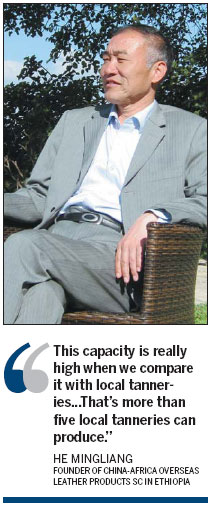
|
Workers in China-Africa Overseas Leather Products SC process raw materials in the factory at Sululta, north of Ethiopia's capital, Addis Ababa. Li Lianxing / China Daily |

A Chinese tannery overcomes initial obstacles to find success in Ethiopia
He Mingliang leather tannery, in central China's Henan province, is a typical success story: Expansion to Africa, a new factory in Ethiopia, sales of leather goods across the globe and a staff of more than 500.
But as with any success story, struggles play an early and defining role. For He's tannery, which had been buying semi-processed leather from Ethiopia since 1985, soaring costs in China during the early 2000s hampered business.
He set his sights on Ethiopia to invest in manufacturing factories, but still had no expansion funds and no basic knowledge of how business was run on the continent.
He says he was scared of possible illnesses in Africa and even regional conflicts.
But He did his homework, making several trips to the country to research how commerce is conducted and to find funding sources. Then came a meeting in Beijing in 2004 with then Ethiopian ambassador Addisalem Balema.
Balema encouraged He and took a great interest in the venture plans. With Balema's help, He got in touch with the China-Africa Development Fund in Beijing three years later.
"CADF turned out to be very interested and decided to support us," he says.
The tannery's subsidiary in Ethiopia, the China-Africa Overseas Leather Products SC, is now quickly becoming a model for the leather industry in the country.
Li Jun, project manager of the CADF in Ethiopia, says it decided to support He's project in Ethiopia for several reasons.
"This is fundamentally a mutually beneficial project that could expand Chinese tanneries to Africa. But more importantly, it could lift the entire industry in Ethiopia and benefit farmers at the most basic level," Li says. "It is also a good opportunity to create jobs, which is the priority for Africa's future sustainable development."
Li also says the reason the CADF chose China-Africa Overseas Leather Products is because the Henan-based parent company has been an industry leader in China for more than half a century and CADF believed its technologies and skills could offer a great opportunity to Ethiopia.
The factories were completed in November 2010 in the town of Sululta, to the north of the capital Addis Ababa.
Operations during the first year were rocky, Li says. Many unexpected events brought disruption and at times daunted his investors in Ethiopia.
"Our Chinese staff were beaten by local workers because they didn't like our management system in which several local workers are guided by one Chinese team leader," he says. "More importantly, locals were told by certain people that our factory was severely polluting (Sululta)."
He says the company values the environment and that the factory was built with particular attention to environmental protection in order to set a tone for the industry in Ethiopia.
